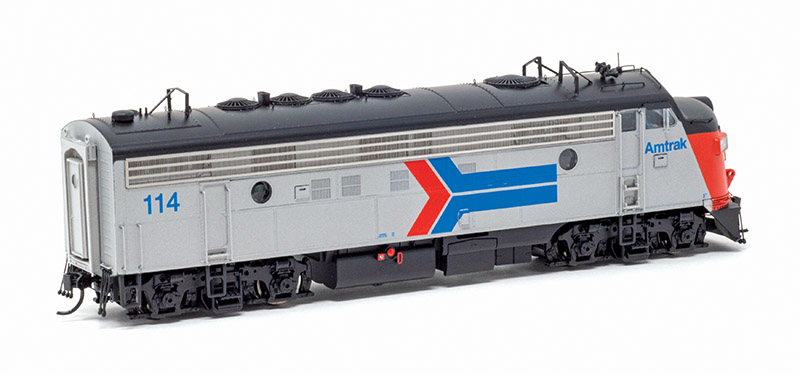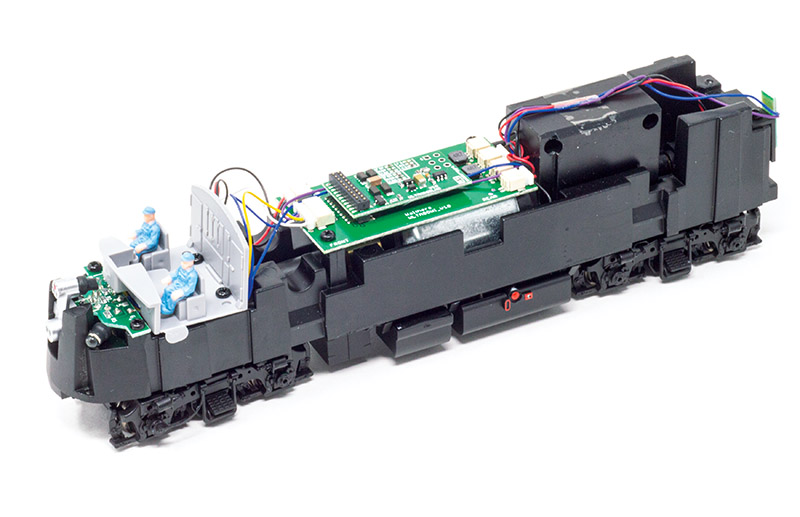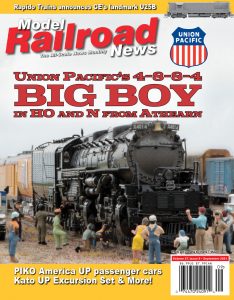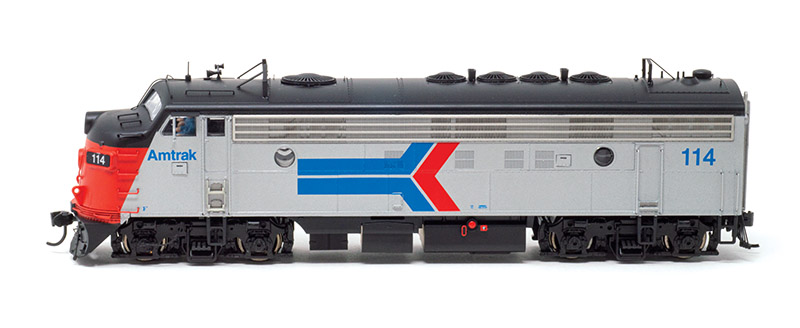
When Amtrak took over most U.S. passenger trains in 1971, it inherited a plethora of passenger locomotives and rolling stock from the Class 1 railroads that previously operated those trains. Most railroads kept their newest locomotives to be reassigned for freight trains, such as Southern Pacific’s SDP45s, Burlington Northern’s (former Great Northern) SDP40s, and The Milwaukee Road’s FP45s, leaving Amtrak with older diesel power consisting of Electro Motive-Division (EMD) E- and F-units. Amtrak would use these secondhand locomotives for its first several years of operation until it could acquire new locomotives like its SDP40F and F40PH. Just in time for the carrier’s 50th anniversary, Walthers has offered a newly tooled Proto-series EMD FP7 in Amtrak’s Phase I paint scheme, a great representation of early motive power that worked the passenger service in the 1970s.

ABOVE: Amtrak 113 shows off the passenger carrier’s Phase I livery on this former Southern Pacific FP7. Trailing power on this Sunset Limited consist includes a pair of FP7s decked out in “Bloody Nose” decoration. The train is at its eastern terminus of New Orleans, La., in late sumer 1973. — Jim Asplund photo, Kevin EuDaly collection
An F-unit for Amtrak
This HO-scale FP7 model represents ex-Southern Pacific 6450, one of 14 FP7s acquired by Amtrak. Southern Pacific purchased 16 FP7s from EMD, with 6450 being built in February 1953. At first glance, this FP7 appears identical to an F7A; however, it is actually four feet longer than a standard F7A to accommodate larger water tanks. These water tanks increased the capacity of the locomotive’s steam generator, which was used for heating passenger cars. This increased capacity made the FP7 better suited for passenger service than F7As equipped with steam generators. Amtrak’s 14 ex-SP FP7s were renumbered 110 through 123, following Amtrak’s standard F7s, and SP 6450 would become Amtrak 114.
Amtrak 114 was repainted in Amtrak’s eye-catching Phase I paint scheme around 1973. The Platinum Mist body, red nose, and large red-and-blue “pointless arrow” logo helped communicate a unified image across Amtrak’s ragtag, secondhand fleet, bringing an end to the “rainbow era” of early Amtrak. Amtrak’s passenger rolling stock received a variation of this scheme with a band around the windows with equal red and blue stripes, a small white stripe, and the pointless arrow logo at the ends of the band. These 14 FP7s saw use across the U.S., but frequently remained on former home turf pulling the successor trains to former Southern Pacific routes, like Amtrak’s Coast Starlight or Sunset Limited. FP7 114’s career at Amtrak would prove to be fairly short, as it was retired by Amtrak in October 1975; some of its sisters would last a few more years before meeting a similar fate.

More Than Another F-Unit
The latest Proto locomotive offering, this FP7 joins Walthers’ existing Proto and Mainline F-units. This is the first new-tooling Proto locomotive in several years, with the previous new model being the manufacturer’s Phase II EMD GP35 in 2017. Its release coincides with Walthers’ The Milwaukee Road Twin Cities Hiawatha name train, but several road names are included beyond Milwaukee. This run includes Amtrak, Southern Pacific (gray-and-red “bloody nose” scheme), Pennsylvania Railroad (single-stripe Brunswick Green), Southern Railway (black, white, and gold scheme), and Soo Line (maroon with Dulux Gold). Multiple road numbers are available for each road name, and Walthers produced A-B set offerings (which include a matching livery F7B). There are six Amtrak FP7 road numbers in this run, three DC models and three with Digital Command Control (DCC) and sound; two numbers are part of FP7A/F7B sets. This model bears a strong resemblance to Walthers’ existing Proto and Mainline F7A. The shape of the nose and windshield appear to be identical to past Walthers F7s. Like Walthers’ other F-unit offerings, this FP7 has see-through rooftop fans with visible, silver-colored fan blades, and see-through, etched-metal side grilles with car body openings and bracing behind them. As expected from a fully detailed model, separately applied grab irons and lift rings come installed on the rendering. Other separately applied parts include etched-metal sun visors, clear-plastic wind deflectors, front and rear air hoses, and see-through steps mounted below the cab doors and side access doors. Also included is a cab interior featuring painted engineer and conductor figures. The Phase I paint scheme is well-represented with colors matching Amtrak’s paint scheme and logo guide, and the pad-printed lettering, such as the tiny “FUEL FILL” labeling above the fuel tank filler cap, is crisp and very legible.
Walthers has tooled detail variations for its HO-scale FP7 to accommodate the six road names produced in this initial run. Like the prototype, several road-specific details make this model easily identifiable as a former Southern Pacific locomotive. A snowplow pilot and rooftop icebreakers for service over mountain passes are unique to the FP7s built for SP; you’ll also find front lift rings above the pilot. The icebreakers were added by SP sometime later in its ownership of these locomotives to break icicles from tunnel portals in mountainous areas, and they remained installed until Amtrak retired these FP7s. The model’s icebreakers are quite sturdy and made of photo-etched metal parts. The air horn is also road-specific, a Nathan M5 mounted above the engineer’s side of the cab. As a former Southern Pacific locomotive, this model includes partial side skirting along the sill in front of the fuel tank, and a frame-mounted equipment box behind the front truck. Since these FP7s are prototype specific, some other road names produced have full skirting or no skirting, and an empty space behind the front truck instead of an equipment box. Additionally, while Walthers’ Amtrak models include a dynamic brake fan behind the cab, some models in this run are represented without dynamic brakes when appropriate. The upper front headlight is a unique triangle configuration with a red, single beam emergency light on top and a dual-beam headlight on the bottom. The upper headlight is functional, as is the lower headlight, but the red emergency light is non-operating. The rear backup light is functional.

Our sample is DCC-ready and includes a 21-pin decoder plug for installation of your choice of decoder to go digital, or operation on standard DC direct from the box. The FP7s with DCC include ESU’s LokSound 5. All lighting on this model uses LEDs, which present realistic warm-white color. Both the upper and lower headlights illuminate when the model is running forward on DC power and the rear backup light illuminates in reverse. The number boards are illuminated by LEDs. Impressively, the top headlight has a flashing mars light effect when operating on DC power, a feature apparently built into the DCC jumper board. The drivetrain on this model is the usual quiet and powerful drive expected from a modern Walthers locomotive and should be well-suited for pulling HO passenger equipment.
Final Thoughts About This F-Unit
Walthers’ newest model in the Proto locomotive line is a great addition to the existing F-unit models from the company. This batch of road names leaves plenty of room for future runs. Some potential options for future paint schemes include two major purchasers of FP7s, Atlantic Coast Line and Louisville & Nashville, but I’d personally love to see Northern Pacific’s two FP7s in the striking Loewy two-tone green scheme. Early Amtrak is an interesting era in railroading, and Walthers has captured a small piece of it with this locomotive.
Wm. K. Walthers
800-4TRAINS
walthers.com
 About the Author – A regular contributor to Model Railroad News, Aaron Adams lives in Washington state and is a recent college graduate. Aaron enjoys contemporary railroading and is an active HO scale modeler.
About the Author – A regular contributor to Model Railroad News, Aaron Adams lives in Washington state and is a recent college graduate. Aaron enjoys contemporary railroading and is an active HO scale modeler.
 This review appears in September 2021’s Model Railroad News.
This review appears in September 2021’s Model Railroad News.



